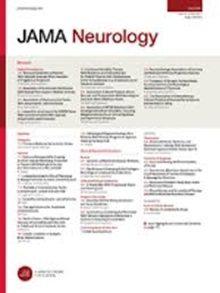临床前阿尔茨海默病患者血浆磷酸化Tau 217、Tau PET和认知的同步变化
IF 21.3
1区 医学
Q1 CLINICAL NEUROLOGY
引用次数: 0
摘要
开发疾病修饰疗法是阿尔茨海默病研究的重点。目的确定血浆磷酸化tau217 (p-tau217)和tau正电子发射断层扫描(PET)在治疗试验中评估疾病改变的潜力。设计、环境和参与者本诊断/预后研究使用了2014年4月至2023年6月收集的无症状阿尔茨海默病抗淀粉样蛋白治疗(A4)研究的纵向数据。参与者从美国、加拿大、澳大利亚和日本的67个地点招募,包括老年人(65-85岁),他们在筛查时认知功能未受损,并接受了淀粉样蛋白PET扫描。没有淀粉样蛋白PET升高的参与者被纳入A4研究的伴随研究,即淀粉样蛋白风险和神经变性的纵向评估(LEARN)研究。曝光18f -florbetapir PET成像。主要结果和测量18f -florbetapir PET成像用于将参与者分类为β淀粉样蛋白(Aβ+)升高。tau的测量包括纵向血浆p-tau217和18F-flortaucipir PET。认知评估使用临床前阿尔茨海默认知复合(PACC)。结果A4研究共纳入1169人,LEARN研究纳入无淀粉样蛋白PET升高的538人。在这1707名参与者中,基线平均(SD)年龄为71.5(4.7)岁,1024名(60%)为女性,683名(40%)为男性;1169名受试者为Aβ+,平均(SD)迷你精神状态检查得分为28.8(1.2)分。tau PET亚研究包括443名参与者;1643名参与者的血浆p-tau217水平可用。在36个月时,Aβ+参与者的纵向tau PET积累效应最大的是颞下回。Aβ+参与者PACC评分纵向变化的基线相关性在内嗅皮层(相关系数[ρ] = - 0.55; 95% CI, - 0.63至- 0.45)和血浆p-tau217水平(ρ = - 0.47; 95% CI, - 0.56至- 0.37)最强。额顶叶区的Tau PET变化与并发认知变化密切相关。血浆P -tau217水平在Aβ+参与者中显著升高,然后出现显著减速(χ2 = 21.7; P & lt;)。在tau PET亚研究中,与并发认知变化无关(ρ = - 0.03; 95% CI, - 0.23至0.16),但与全血浆样本中并发认知变化有中度相关(n = 1119; ρ = - 0.24; 95% CI, - 0.34至- 0.14)。结论和相关性本研究发现tau PET在预后和实时跟踪疾病进展方面都有价值。血浆p-tau217预测明显认知障碍之前的认知变化,并能有效地指导参与者的选择。在未来的阿尔茨海默病试验中,基于成像的tau测量可能会增强疾病修饰效应的检测并完善治疗靶点。本文章由计算机程序翻译,如有差异,请以英文原文为准。
Concurrent Changes in Plasma Phosphorylated Tau 217, Tau PET, and Cognition in Preclinical Alzheimer Disease
ImportanceDeveloping disease-modifying treatments is a priority for Alzheimer disease research.ObjectiveTo determine the potential of plasma phosphorylated tau 217 (p-tau217) and tau positron emission tomography (PET) to assess disease modification in treatment trials.Design, Setting, and ParticipantsThis diagnostic/prognostic study used longitudinal data from the Anti-Amyloid Treatment in Asymptomatic Alzheimer’s Disease (A4) study collected from April 2014 to June 2023. Recruited from 67 sites in the US, Canada, Australia, and Japan, participants included older individuals (age 65-85 years) who were cognitively unimpaired at screening and underwent an amyloid PET scan. Participants without elevated amyloid PET were included from a companion to the A4 study, the Longitudinal Evaluation of Amyloid Risk and Neurodegeneration (LEARN) study.Exposure18 F-florbetapir PET imaging.Main Outcomes and Measures18 F-florbetapir PET imaging was used to classify participants as having elevated amyloid β (Aβ+). Measures of tau included longitudinal plasma p-tau217 and 18 F-flortaucipir PET. Cognition was assessed using the Preclinical Alzheimer Cognitive Composite (PACC).ResultsA total of 1169 individuals were included from A4 Study and 538 without elevated amyloid PET were included from the LEARN Study. Among these 1707 participants, the baseline mean (SD) age was 71.5 (4.7) years, 1024 (60%) were female, and 683 (40%) male; 1169 participants were Aβ+, and the mean (SD) Mini-Mental State Examination score was 28.8 (1.2). The tau PET substudy included 443 participants; plasma p-tau217 levels were available for 1643 participants. The largest effect size of longitudinal tau PET accumulation at 36 months in Aβ+ participants was in the inferior temporal gyrus. Baseline associations with longitudinal change in PACC score in Aβ+ participants were strongest in the entorhinal cortex (correlation [ρ] = −0.55; 95% CI, −0.63 to −0.45) and plasma p-tau217 levels (ρ = −0.47; 95% CI, −0.56 to −0.37). Tau PET changes in frontoparietal regions were strongly correlated with concurrent cognitive changes. Levels of plasma p-tau217 increased significantly in Aβ+ participants before showing significant deceleration (χ2 = 21.7; P < .001) and were not associated with concurrent cognitive change in the tau PET substudy (ρ = −0.03; 95% CI, −0.23 to 0.16) but were modestly associated with concurrent cognitive changes in the full plasma sample (n = 1119; ρ = −0.24; 95% CI, −0.34 to −0.14).Conclusions and RelevanceThis study found that tau PET is valuable for both prognostic and real-time tracking of disease progression. Plasma p-tau217 predicts cognitive changes prior to overt cognitive impairment and can efficiently guide participant selection. Imaging-based tau measures may enhance detection of disease-modifying effects and refine therapeutic targets in future Alzheimer disease trials.
求助全文
通过发布文献求助,成功后即可免费获取论文全文。
去求助
来源期刊

JAMA neurology
CLINICAL NEUROLOGY-
CiteScore
41.90
自引率
1.70%
发文量
250
期刊介绍:
JAMA Neurology is an international peer-reviewed journal for physicians caring for people with neurologic disorders and those interested in the structure and function of the normal and diseased nervous system. The Archives of Neurology & Psychiatry began publication in 1919 and, in 1959, became 2 separate journals: Archives of Neurology and Archives of General Psychiatry. In 2013, their names changed to JAMA Neurology and JAMA Psychiatry, respectively. JAMA Neurology is a member of the JAMA Network, a consortium of peer-reviewed, general medical and specialty publications.
 求助内容:
求助内容: 应助结果提醒方式:
应助结果提醒方式:


